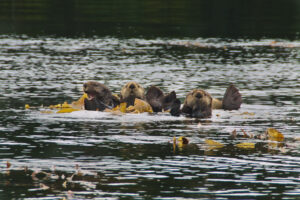Grade 4 - The Case of the Missing Sea Otters
SUMMARY
A 3-5 Week Science Unit for Intermediate Level
This unit is designed for 4th grade but could be adapted for use at any of the intermediate grades. Students develop an understanding of how organisms in aquatic environment are connected to each other through four investigations that weave together the story of “The Case of the Missing Sea Otters.” Students participate in a sampling simulation, make predictions, and try to solve the mystery of the missing otters. They then apply their knowledge of ecosystems to their local aquatic environment. Finally, students share their collected data with other classrooms around the state.
Essential Question
-
In what ways are organisms in aquatic environments connected to each other?
Enduring Understandings
- Organisms in aquatic habitats interact with and depend on one another in various ways.
- An ecosystem is a community of living things with its physical environment, functioning as a unit.
- Science is a way to help us study the many connections in our world.
Ocean Literacy Principles Addressed
- The ocean supports a great diversity of life and ecosystems.
- The ocean and humans are inextricably interconnected.
LESSON PLANS

How Do Scientists Learn about Ecosystems?
In this 3-4 day investigation, students revisit the sea otter mystery story and discuss what scientists did to study sea otters in the Aleutians. They simulate the observation, identification, sampling, and counting methods used by scientists in two different activities, then reflect, discuss, and pose questions about scientific data collection.
View Lesson Plan
Interconnections
In this 4-5 day investigation, students examine hypotheses and evidence related to the causes of the sea otter decline. They narrow down the hypotheses to one, then play a food web game to help them better understand relationships in the kelp bed ecosystem, and predict the outcome of an experiment to test the killer whale predation hypothesis. They put together some of the big ideas about interactions in ecosystems to come up with plausible explanations for the sea otter mystery. Finally, they evaluate whether the hypothesis has been proven. They reflect on their learning by diagramming the sea otter’s food web and predicting what might happen if parts of the ecosystem changed.
View Lesson Plan Grade 4
Location: Large Space
Activity Type: Game, Project

The Missing Sea Otters
In this 4-5 day investigation, students begin by reading a mystery story about sea otters in the Aleutian Islands, and examining an accompanying population graph. They identify information that they will need to help them solve the missing sea otter mystery, and explore ecological relationships in the sea otter environment using Web sites, video clips, and readings. Information is shared with the class and/or summarized on clue cards, and students then create murals showing the sea otter/kelp bed ecosystem.
View Lesson Plan Grade 4
Location: Classroom
Activity Type: Hands-On, Multimedia, Project
AUTHORS
Jennifer Thompson, Teacher, Gastineau School, Juneau
Elissa Borges, Teacher, Gastineau School, Juneau
Paula Savikko, Teacher, Gastineau School, Juneau
Marilyn Sigman, Scientist, Center for Alaskan Coastal Studies, Homer
Stephanie Hoag, Curriculum Consultanta
